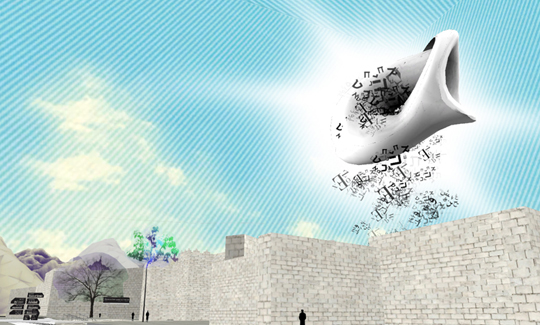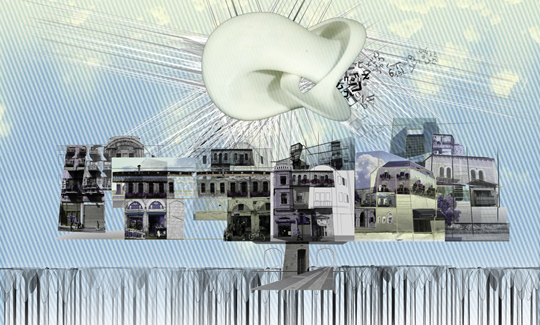Lila Chitayat
In collaboration with the Bloomfield Science Museum, Jerusalem
Graphic design: Ori Succary Studio
My Ideal Jerusalem, 2010
Installation, mixed media
Courtesy of the artist
In 1917, Boris Schatz began writing a utopian novel called Jerusalem Rebuilt. He described how Bezalel Ben Uri, the chief artisan of the Tabernacle, appeared to him on the roof of the Bezalel building and how both travelled through the Land of Israel a hundred years later, in the year 2017. The utopian descriptions are full of fabulous representations – the wonders of the country's buildings (palaces of columns and crystal, magical chalets), its institutions, and its people ("Only the best and chosen ones of the people, only people with ideals came to live with us").
The book also discusses the importance of the alliance between art and science in shaping the Jerusalem of the future: "Jerusalem has become a cultural center for Jews. It is the pride, the soul of the people. The People of Israel buy all their religious articles and artistic objects here […] Jerusalem is rich, and it gives all its richness in support of science and art, which bring happiness to the world, especially to the other Jews of the whole world."
Lila Chitayat's project was created in the future age, which Schatz wrote about. The ancient metaphysical yearning for building the Jerusalem of heaven encounters, in her work, contemporary theories discussing the space of positive developments that can occur in the wake of technological innovations. Her project seeks to explore the potential of cyberspace and virtual technological worlds as tools for improving the city's urban and social conditions. The process of Jerusalem's "idealization" is based on an analysis of the residents' visions. Residents of the city were asked to propose ideas for mending the existing city's reality, and to plan the ideal city.
"My Ideal City" was a global virtual project conducted in four cities – Venice, Copenhagen, Lisbon, and Jerusalem, commissioned by the European Union and the Bloomfield Science Museum. According to Chitayat:
"Working with computer game technology allowed people to wander through virtual space as avatars and to meet other people. The citizens of Jerusalem imagined an ideal city that was very different from that of the citizens of other cities. They shared deep anxiety for the other, and a severe lack of futuristic, metaphysical, fantastic vision.
Three-dimensional models of the city, real and virtual, depicted the complex ideal city. From outside it looks like a cluster of small, semi-autonomous communities that wish to live apart. When you enter, you see layers of the past and the future. So, when you wander through space you can sense kaleidoscopic visions on every level.
The virtual city was planned in the form of a Möbius strip, connecting the west side with the east. The separate clusters cease to exist, and the virtual site offers a platform for discussing ideas of coexistence, an absence of government, and layered histories."
Lila Chitayat was born in Jerusalem, 1970; lives and works in Tel Aviv.



